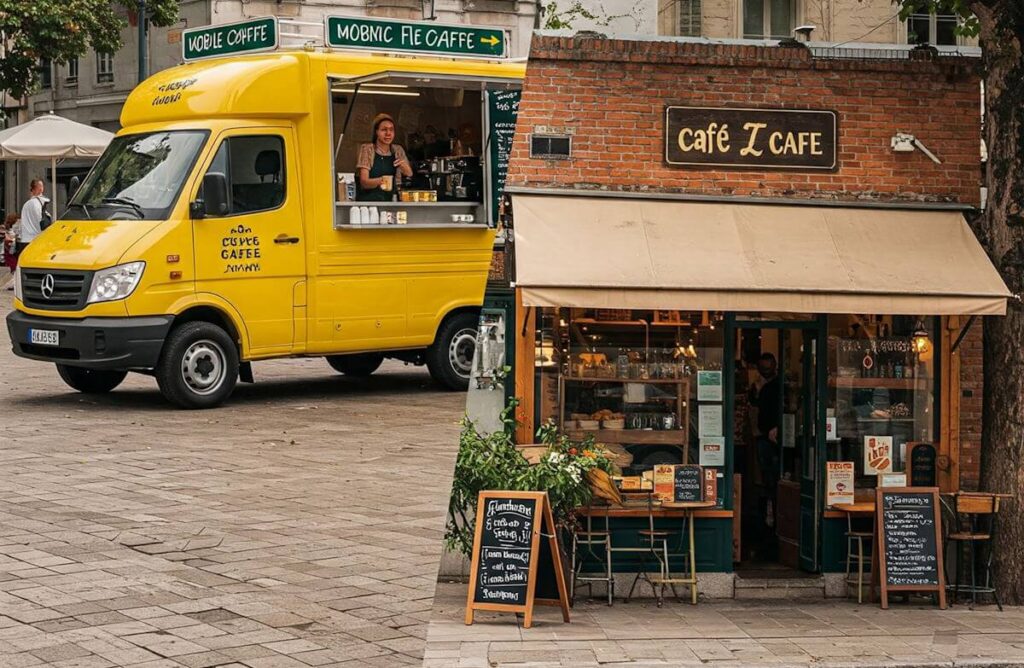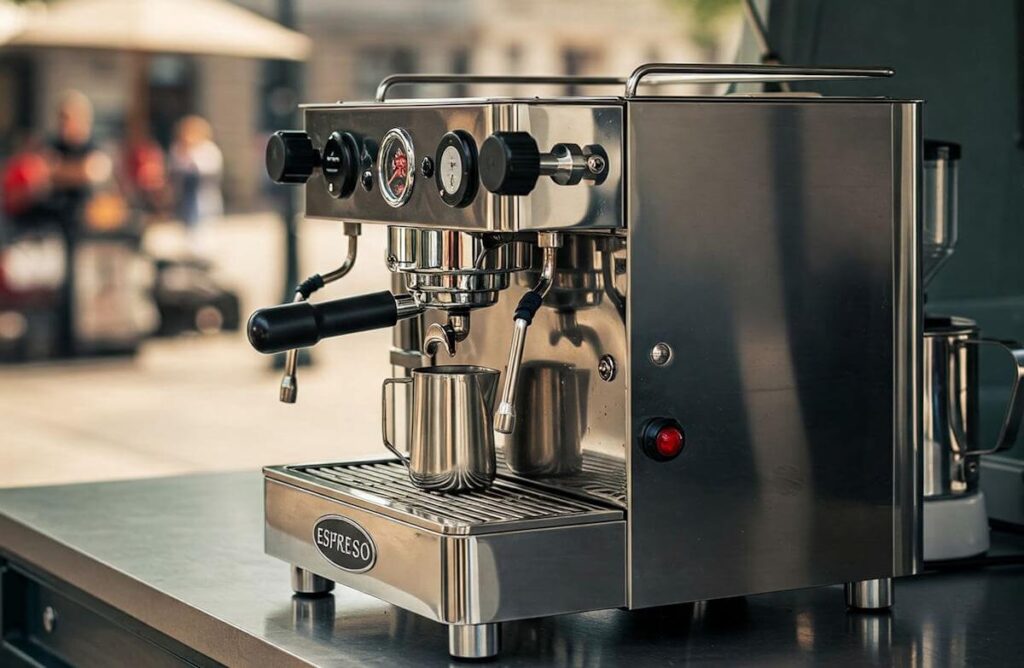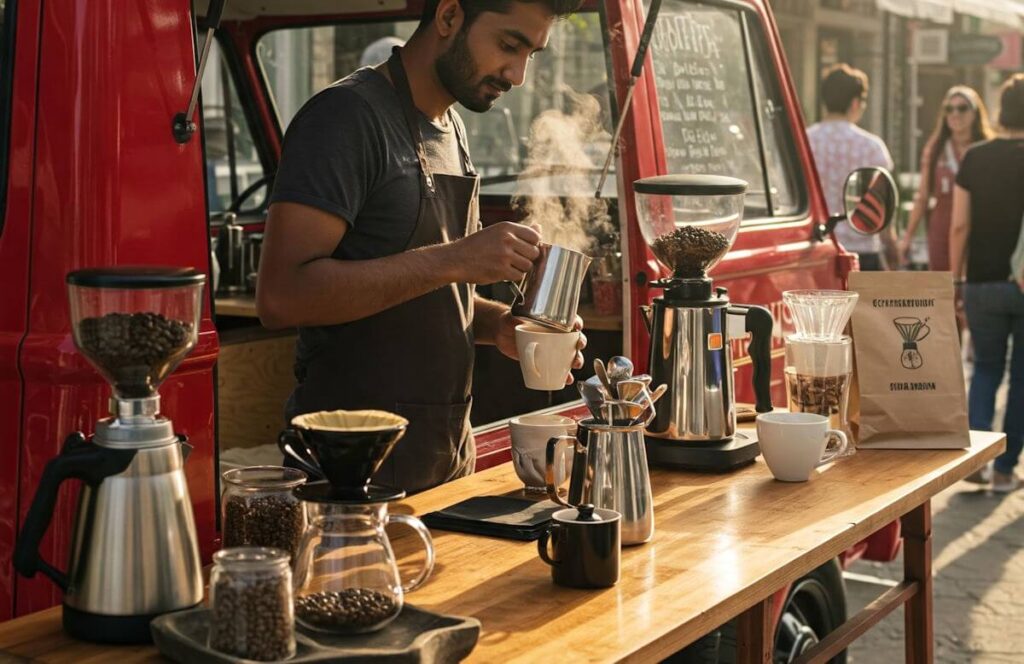The landscape of the coffee industry has evolved significantly, giving rise to two distinct categories of establishments: mobile cafés and brick-and-mortar cafés. Each type presents unique advantages and challenges, serving different customer needs and preferences. Understanding these differences is crucial for aspiring café owners and coffee enthusiasts alike.
Mobile cafés operate from vehicles, trailers, or portable setups, offering an innovative and flexible approach to the traditional coffee business. These cafés bring the beverage experience directly to consumers in various locations, including parks, festivals, and urban centers. One of the most attractive features of mobile cafés is their lower start-up costs compared to their stationary counterparts. Entrepreneurs can often circumvent significant expenses such as rent and utilities, thus allowing for a more streamlined investment process. Additionally, mobile cafés can adapt quickly to changing market trends, targeting different demographics by simply relocating to new areas or events.
Conversely, brick-and-mortar cafés are permanent establishments that require substantial investment and commitment. These cafés have fixed locations, ideally situated to attract foot traffic. Entrepreneurs must navigate the complexities of finding a suitable space, leasing agreements, and the associated costs of renovation and furnishings. However, the stationary nature of brick-and-mortar cafés offers benefits such as a consistent customer base and the potential for creating a unique ambiance and community hub. Additionally, these cafés can provide a wider variety of products and services, enhancing customer loyalty and fostering longer visits.
In essence, while mobile cafés and brick-and-mortar cafés each serve coffee lovers, their operational models, start-up investments, and customer engagement approaches differ significantly. Understanding these distinctions will aid potential business owners in making informed decisions about which café model aligns with their vision and goals.
Understanding Your Target Audience
Identifying and comprehending your target audience is a vital component in determining whether a mobile café or a brick-and-mortar establishment is the most appropriate model for your business. The first step in this process involves conducting thorough market research, which helps in understanding the demographics of your potential customers. For instance, consider factors such as age, income level, and lifestyle choices, as these elements can significantly influence the kind of café one might want to establish.
Demographics are not the sole aspect to analyze; customer preferences also play a crucial role in shaping your offerings. Mobile cafés are often preferable in areas where convenience is a priority. They attract customers who may be pressed for time or those seeking a quick coffee fix on their way to work or during their daily activities. Conversely, brick-and-mortar cafés might appeal more to individuals who appreciate a comfortable environment to socialize, study, or unwind. Recognizing these preferences can help you tailor your services and menu accordingly.
Additionally, understanding customer habits can greatly inform your operational strategies. For mobile cafés, insights into peak times for foot traffic can assist in determining optimal locations and times for service. In contrast, brick-and-mortar cafés may benefit from understanding the social dynamics of their locality, including events and gatherings that could increase customer inflow. By observing and analyzing these habits, one can make informed decisions that align with the expectations and needs of the target market.
Integrating these insights into your business strategy not only enhances operational efficiency but also fosters customer loyalty. Ultimately, achieving a sophisticated understanding of your target audience ensures that your café model, whether mobile or stationary, resonates effectively with the market you aim to serve.
Cost Analysis: Initial Investment and Operating Expenses
The financial commitment required to establish a café can vary significantly between mobile cafés and brick-and-mortar establishments. Analyzing the initial investment and ongoing operating expenses will elucidate which option is more suitable for aspiring café owners, particularly within the context of startup costs, equipment, permits, rent, utilities, and staffing.
Initially, mobile cafés typically demand a lower startup investment compared to their brick-and-mortar counterparts. The principal expense for a mobile café often includes the cost of the vehicle, which can vary based on size and type. Additionally, equipment such as espresso machines, grinders, and blenders must be purchased; however, these costs can be lower than outfitting a full kitchen. Necessary permits, which may include health permits and business licenses, also need to be considered, but they tend to be less convoluted for mobile operations.
In contrast, starting a brick-and-mortar café generally necessitates a more substantial financial outlay. Prospective owners should anticipate costs for lease or purchase of real estate, which varies greatly depending on location. Generally, urban locations, with their higher foot traffic, come with increased rent. Furthermore, utilities can accumulate quickly in a traditional setting, including electricity, water, and gas, which should be thoroughly evaluated during budgeting.
Staffing expenses are another critical aspect of operational costs. Mobile cafés might operate with a leaner team, allowing for reduced payroll expenditures. On the other hand, brick-and-mortar cafés require additional staff to manage a larger space efficiently, resulting in higher ongoing labor costs. As a result, the choice between these two models should involve a comprehensive review of financial implications tailored to individual business goals and regional market conditions.
Location, Location, Location: Advantages and Disadvantages
When considering whether to operate a mobile café or a brick-and-mortar establishment, one of the most crucial factors to examine is location. Mobile cafés, by nature, offer flexibility; they can travel to various locations, allowing them to capitalize on high-demand events, festivals, and busy urban areas. This movement enables mobile cafés to reach diverse customer bases that a stationary café might not engage. For instance, a mobile café can set up in areas during peak hours, whether at a bustling market or a popular local event, ensuring that it is strategically placed for maximum visibility and foot traffic.
On the other hand, brick-and-mortar cafés benefit from a fixed location, which provides a sense of stability and brand recognition. Establishing a café in a strategically chosen area can greatly influence its success. High foot traffic locations, such as those near universities, shopping centers, or office buildings, can continuously draw in customers. Additionally, a permanent location can create a loyal customer base, as patrons often appreciate the predictability of knowing exactly where to find their favorite café. Accessibility is another vital aspect; a well-placed brick-and-mortar café can become a gathering hub for the community, fostering a sense of belonging among its customers.
However, both mobile and fixed cafés face challenges related to location. Mobile cafés may struggle with finding optimal parking spaces or dealing with restrictions in certain areas. Conversely, brick-and-mortar cafés often incur higher overhead costs, including rent, utilities, and maintenance, which can limit their operational flexibility. Recognizing these advantages and disadvantages allows potential business owners to make informed decisions about which model best aligns with their vision and operational strategies.
Flexibility and Scalability: The Dynamic Nature of Mobile Cafés
Mobile cafés represent a growing trend in the food service industry, characterized by their inherent flexibility and scalability. Unlike traditional brick-and-mortar establishments, mobile cafés can adapt to diverse events, seasons, and changing market demands, allowing them to operate in a variety of environments. This adaptability is crucial for entrepreneurs who seek to minimize startup risks while maximizing their potential reach and profitability.
The primary advantage of a mobile café is its ability to relocate with ease. This mobility enables owners to establish a presence at festivals, farmers’ markets, corporate events, and community gatherings, thus catering to fluctuating customer bases. By strategically selecting locations and timings, mobile cafés can optimize their service offerings to meet consumer demands effectively. As seasons change, mobile cafés can adjust their menus and services accordingly, introducing seasonal specialties that resonate with local preferences.
Moreover, scalability is a significant consideration for mobile café operators. While brick-and-mortar establishments can often reorganize their operational structure more slowly, mobile cafés can expand or contract their services in a more dynamic manner. In periods of high demand, operators can scale up their operations by adding more units or increasing staff, allowing for better resource utilization. Conversely, during slower months, they can simplify their operations without the burden of maintaining a permanent location. However, challenges remain in managing logistics, securing permits, and maintaining consistent quality across multiple locations, which requires meticulous planning and execution.
In summary, mobile cafés exemplify a unique business model that prioritizes flexibility and scalability. Their capacity to adapt quickly to market demands and geographic shifts offers significant advantages, although they must navigate challenges that arise from such dynamic operations. Ultimately, the choice between a mobile café and a brick-and-mortar establishment depends on individual business goals and operational strategies.
Community Engagement and Brand Loyalty Development
Building a strong connection with the community is vital for any café, regardless of its operational model. Mobile cafés and brick-and-mortar establishments both have unique strategies to foster community engagement and cultivate brand loyalty. The primary advantage of mobile cafés lies in their flexibility; they can easily be present at local events, farmers’ markets, and community gatherings, which allows them to directly engage with potential customers. This adaptability helps a mobile café to create a familiar brand presence across different locations, establishing a rapport with diverse community members. By participating in local events, mobile cafés not only promote their brand but also demonstrate their commitment to the community.
Conversely, brick-and-mortar cafés benefit from a permanent location where they can build deep-rooted relationships with customers. They create a sense of belonging by hosting various events such as open mic nights, art showcases, or community discussion forums. Such activities encourage customer interaction and create an inviting atmosphere that fosters loyalty. Establishing a community-centric identity is essential for brick-and-mortar cafés, as it enables them to differentiate from their competitors through unique local experiences.
In both cases, leveraging social media marketing is crucial for building brand loyalty. Mobile cafés can use platforms like Instagram and Facebook to showcase their daily locations, promote their participation in local events, and engage with customers through live updates. This real-time interaction enhances the sense of community and strengthens brand recognition. Brick-and-mortar cafés can utilize these platforms to share customer stories, highlight community involvement, and promote in-house events, thus creating a narrative that resonates with their customers. Overall, both business models can effectively build community connections and foster brand loyalty by implementing tailored strategies that align with their respective operational strengths.
Operational Challenges: Navigating Regulations and Logistics
Both mobile cafés and brick-and-mortar establishments face a myriad of operational challenges, particularly in terms of navigating regulations and logistics. The differences between these two formats can significantly influence the ease or difficulty of compliance with local laws and operational frameworks.
For mobile cafés, one of the primary challenges involves obtaining the necessary permits and licenses to operate legally. This often includes health permits, food handling certifications, and possibly even local business licenses. Mobile food vendors must adhere to strict health codes designed to safeguard public safety, which can vary significantly from one locality to another. Moreover, these businesses frequently need to secure permissions to park and operate in various locations, addressing any zoning restrictions that can limit where they can serve customers. This adds a layer of complexity not typically encountered by traditional brick-and-mortar cafés.
On the other hand, brick-and-mortar cafés, while having more stable operational roots, must ensure compliance with a range of regulations that can be just as demanding. These include stringent health codes, building safety standards, and local zoning laws. Establishing a location requires an in-depth understanding of these regulations, along with potential inspections from health departments. Additionally, once established, these cafés have fixed operating costs, including rent, utilities, and staffing, all of which need meticulous management to maintain operational viability.
Logistical challenges further complicate both operational models. Mobile cafés must carefully consider their supply chain logistics, including the procurement of ingredients and managing inventory onboard. Conversely, brick-and-mortar cafés face challenges in customer traffic patterns and optimizing their service design to enhance the customer experience. Ultimately, both operational models require rigorous planning and adherence to compliance regulations to thrive in the competitive food service market.
Customer Experience: Creating Memorable Moods and Atmospheres
When comparing mobile cafés and brick-and-mortar establishments, the customer experience often emerges as a determining factor in consumer preference. Each café model offers distinctive atmospheres that can shape how patrons perceive their time spent at these venues, influencing their level of satisfaction and loyalty. In brick-and-mortar cafés, the ambiance is usually carefully designed, with considerations for decor, seating arrangements, and lighting that create inviting or thematic spaces. The tactile experience of sitting in a traditional café, along with the sensory stimulation from sights and sounds, encourages social interaction and often provides a sense of comfort and belonging.
Conversely, mobile cafés present a unique twist on the customer experience. Though they may lack the established ambiance of a physical location, they are capable of creating memorable experiences through mobility and novelty. The outdoor setting of a mobile café can enhance the overall atmosphere, particularly when positioned at events or locations that attract large gatherings. Patrons may enjoy the spontaneity of discovering these cafés as opposed to the familiarity of a brick-and-mortar spot. Additionally, the service style of mobile cafés often fosters a more vibrant interaction between staff and customers, which can lead to a personalized experience that resonates with individuals on a level distinct from traditional cafés.
Both mobile and brick-and-mortar cafés grant opportunities for high-touch service, but the format greatly influences customer interactions. In a brick-and-mortar setting, baristas can engage in deeper conversations, establishing rapport with regular customers and fostering a loyal clientele. In a mobile setup, interactions are often brief, yet quick, friendly exchanges can make a strong impression. This contrasts underlines the diversity of customer experiences across different café models. Ultimately, the choice between a mobile or a brick-and-mortar café should align with the desired customer experience and the targeted audience demographic, as both have unique advantages that contribute to memorable moments.
Conclusion: Making the Right Choice for Your Vision
In contemplating the decision between a mobile café and a brick-and-mortar establishment, it is crucial for potential café owners to align their business approach with their personal vision and long-term objectives. Each option offers distinct advantages and challenges that cater to various entrepreneurial aspirations. For instance, a mobile café allows for greater flexibility and the opportunity to engage with diverse customer bases at different locations, thereby tapping into a wider market. This model is particularly advantageous for individuals who value adaptability and want to experiment with various neighborhoods or events without the constraints of a permanent location.
In contrast, a brick-and-mortar café presents stability and the potential for establishing a loyal customer community. This traditional model often benefits from foot traffic and the opportunity for customers to have consistent experiences in a familiar setting. For many aspiring café owners, creating a strong brand identity and cultivating a local following may resonate more with their vision, making the brick-and-mortar route a compelling choice.
When making this pivotal decision, it is essential to consider not only the financial implications but also the personal motivations and lifestyle preferences that accompany each option. Evaluating market opportunities in your area can also inform which model may yield the best results. Ultimately, understanding the unique benefits of both a mobile café and a brick-and-mortar café will empower you to make a well-informed choice that aligns with your goals. Reflect on your aspirations, engage with potential customers, and take a comprehensive look at the logistical factors to select the café model that will best serve your vision and desired impact in the community.




